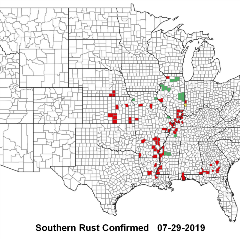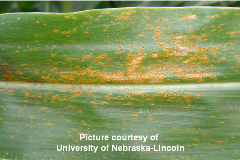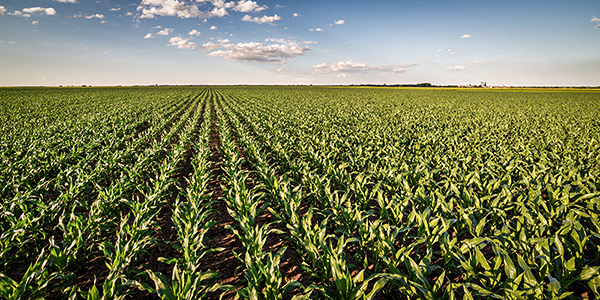AGRONOMICSUPPORT
YOU CAN TAKETO THE FIELD
Southern Corn Rust
Once again, this yield-robbing disease has begun its march north from the lower Mississippi Delta up on to the lower Ohio Valley. While it has been lurking in the extreme south for several weeks, only after the recent tropical storm Barry did the Southern Corn Rust (SCR) spores see a major spread northward. 

View the most recent Southern Rust map here.
SCR moves and affects the crop differently each year. Disease severity and loss depend on crop development and weather patterns through the summer. Late planted corn is most at risk, so much of the lower and mid corn belt is in a “high risk” area in 2019. Hybrids vary in their response to SCR but with extreme pressure even the most tolerant can be affected. It is important to be aware of the disease and try to treat ahead of a major outbreak. (*Southern Rust Ratings for LG hybrids can be found in the LG Seeds Product Guide or from your local LG Seeds Sales Account Manager)
Southern Rust Characteristics
The disease cycle is about 5-10 days. Spores are like a powdery cluster around the pustules. Infections are increased when leaves are moist with dews for 12-15 hours. Several weeks of infection can eventually kill the upper leaves and yield losses can be in the 20 to 50-bushel range depending on how early and how long it infected the plants.
SCR forms pustules that are light cinnamon to orangish brown in color and usually surrounded by a yellow halo. While similar to SCR, Common rust is not a bright orange and is only a minor threat to most hybrids. SCR pustules are usually found on upper leaf surfaces while common rust may be found on both upper and lower surfaces. Both forms can be found on the same plants.
Identifying Southern Corn Leaf Rust 

What to Do:
- Scout, talk to neighbors, and utilize university information in your state.
- Remember, fungicides do not actually control the disease but can serve to suppress it beyond the time where it adversely affects yield. Continued high disease pressure can overwhelm even the best fungicide products.
- Fungicides may provide 2-3 weeks of protection with a few products advertising up to 42 days.
- The economics of applying fungicides should be seriously considered. Total costs including application are often in the $30-35 range, so the potential ROI may still be in question.
- Example: assume $4.00 corn at harvest and a $35.00 fungicide treatment cost, your ROI must be at least 9 bushels per acre.
- Dual or triple mode of action fungicides are highly recommended.
- Using multiple mode of action products also gives you a broader spectrum of control of other common diseases like Gray Leaf Spot and Northern Corn Leaf Blight.
- If your crop is at late dough stage or later (R4-R5) when SCR is detected, spraying may not be warranted due to the lessened impact on yield.
Conclusion:
Southern Corn Rust in on the move. If you see or hear it reported in nearby counties especially to the south of your operation, then chances are you have it or soon to get it. Spraying decisions are made even harder this year due to the already diminished yield potential of the crop. Consult your local LG Seeds Sales Account Manager, Technical Team Agronomist or your local ag chem supplier for more information.
References and Additional Information:
- Bradley, Carl A. 2016. Update on Southern Rust of Corn. https://kentuckypestnews.wordpress.com/2016/07/19/update-on-southern-rust-of-corn/
- Wise, Kiersten. 2010. Common and Southern Rusts. Purdue University Publications. BP-82-W. 4 pp. https://www.extension.purdue.edu/extmedia/BP/BP-82-W.pdf
- Wise, Kiersten. 2015. Fungicide Efficacy for Control of Corn Diseases. Purdue University Publication. BP-160-W. 2 pp. https://www.extension.purdue.edu/extmedia/BP/BP-160-W.pdf






Technical Team Agronomist